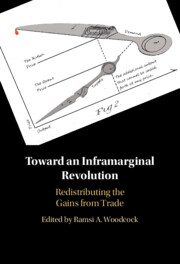Refine search
Actions for selected content:
371 results
Judicial Review of Restrictions on the Right to Conduct Business in the Czech Republic During the COVID-19 Pandemic: Lessons for Future Crises
-
- Journal:
- European Journal of Risk Regulation , First View
- Published online by Cambridge University Press:
- 15 October 2025, pp. 1-13
-
- Article
-
- You have access
- Open access
- HTML
- Export citation
Are women progressing to leadership roles in the wine industry? Evidence from Australia
-
- Journal:
- Journal of Wine Economics , First View
- Published online by Cambridge University Press:
- 08 October 2025, pp. 1-14
-
- Article
-
- You have access
- Open access
- HTML
- Export citation
Poverty in Judgecraft: New Narratives through the Language of Equality – CORRIGENDUM
-
- Journal:
- German Law Journal ,
- Published online by Cambridge University Press:
- 02 October 2025, p. 1
-
- Article
-
- You have access
- Open access
- HTML
- Export citation

Toward an Inframarginal Revolution
- Redistributing the Gains from Trade
-
- Published online:
- 26 September 2025
- Print publication:
- 16 October 2025
Documenting the profession: Recording historic access and retention issues for women in UK archaeology
-
- Journal:
- Archaeological Dialogues , First View
- Published online by Cambridge University Press:
- 26 September 2025, pp. 1-25
-
- Article
-
- You have access
- Open access
- HTML
- Export citation
International Law, the Courts, and the Political Branches of Singapore: Painting a Complete Picture
-
- Journal:
- Asian Journal of International Law , First View
- Published online by Cambridge University Press:
- 15 September 2025, pp. 1-24
-
- Article
-
- You have access
- Open access
- HTML
- Export citation

Democracy's Double Helix
- Participation, Equality and Revolution in Early Modern Europe
-
- Published online:
- 09 September 2025
- Print publication:
- 14 August 2025
The Long Legacy of Apartheid Geography and the Reach of the South African Constitution’s Equality Clause
-
- Journal:
- German Law Journal / Volume 26 / Issue 2 / March 2025
- Published online by Cambridge University Press:
- 01 September 2025, pp. 198-212
-
- Article
-
- You have access
- Open access
- HTML
- Export citation
Practices of Social Constitutionalism: Poverty, Socio-economic Status and Social Exclusion in the Jurisprudence of the German Federal Constitutional Court
-
- Journal:
- German Law Journal / Volume 26 / Issue 2 / March 2025
- Published online by Cambridge University Press:
- 01 September 2025, pp. 213-233
-
- Article
-
- You have access
- Open access
- HTML
- Export citation
Poverty in Judgecraft: New Narratives through the Language of Equality
-
- Journal:
- German Law Journal / Volume 26 / Issue 2 / March 2025
- Published online by Cambridge University Press:
- 01 September 2025, pp. 170-197
-
- Article
-
- You have access
- Open access
- HTML
- Export citation
6 - Too Much, Too Little, Too Unlikely
-
- Book:
- Multispecies Legality
- Published online:
- 18 June 2025
- Print publication:
- 21 August 2025, pp 129-148
-
- Chapter
- Export citation
4 - Reformation and Confessional Pluralism
- from Part II - Notions and Practices of Equality
-
- Book:
- Democracy's Double Helix
- Published online:
- 09 September 2025
- Print publication:
- 14 August 2025, pp 129-140
-
- Chapter
- Export citation
8 - The Enlightenment
- from Part II - Notions and Practices of Equality
-
- Book:
- Democracy's Double Helix
- Published online:
- 09 September 2025
- Print publication:
- 14 August 2025, pp 171-184
-
- Chapter
- Export citation
A New History of the Birth of Modern Democracy
-
- Book:
- Democracy's Double Helix
- Published online:
- 09 September 2025
- Print publication:
- 14 August 2025, pp 1-28
-
- Chapter
- Export citation
5 - Trade, Markets, Capitalism
- from Part II - Notions and Practices of Equality
-
- Book:
- Democracy's Double Helix
- Published online:
- 09 September 2025
- Print publication:
- 14 August 2025, pp 141-150
-
- Chapter
- Export citation
7 - States, Subjects, Citizens
- from Part II - Notions and Practices of Equality
-
- Book:
- Democracy's Double Helix
- Published online:
- 09 September 2025
- Print publication:
- 14 August 2025, pp 161-170
-
- Chapter
- Export citation
2 - Law’s Response to Disfigurement Inequality
-
- Book:
- Appearance, Disability and the Law
- Published online:
- 31 July 2025
- Print publication:
- 14 August 2025, pp 10-26
-
- Chapter
- Export citation
6 - Natural Law and Individual Rights
- from Part II - Notions and Practices of Equality
-
- Book:
- Democracy's Double Helix
- Published online:
- 09 September 2025
- Print publication:
- 14 August 2025, pp 151-160
-
- Chapter
- Export citation
From Past to Future
-
- Book:
- Democracy's Double Helix
- Published online:
- 09 September 2025
- Print publication:
- 14 August 2025, pp 288-306
-
- Chapter
- Export citation
3 - Law’s Limited Ambitions
-
- Book:
- Appearance, Disability and the Law
- Published online:
- 31 July 2025
- Print publication:
- 14 August 2025, pp 27-40
-
- Chapter
- Export citation
